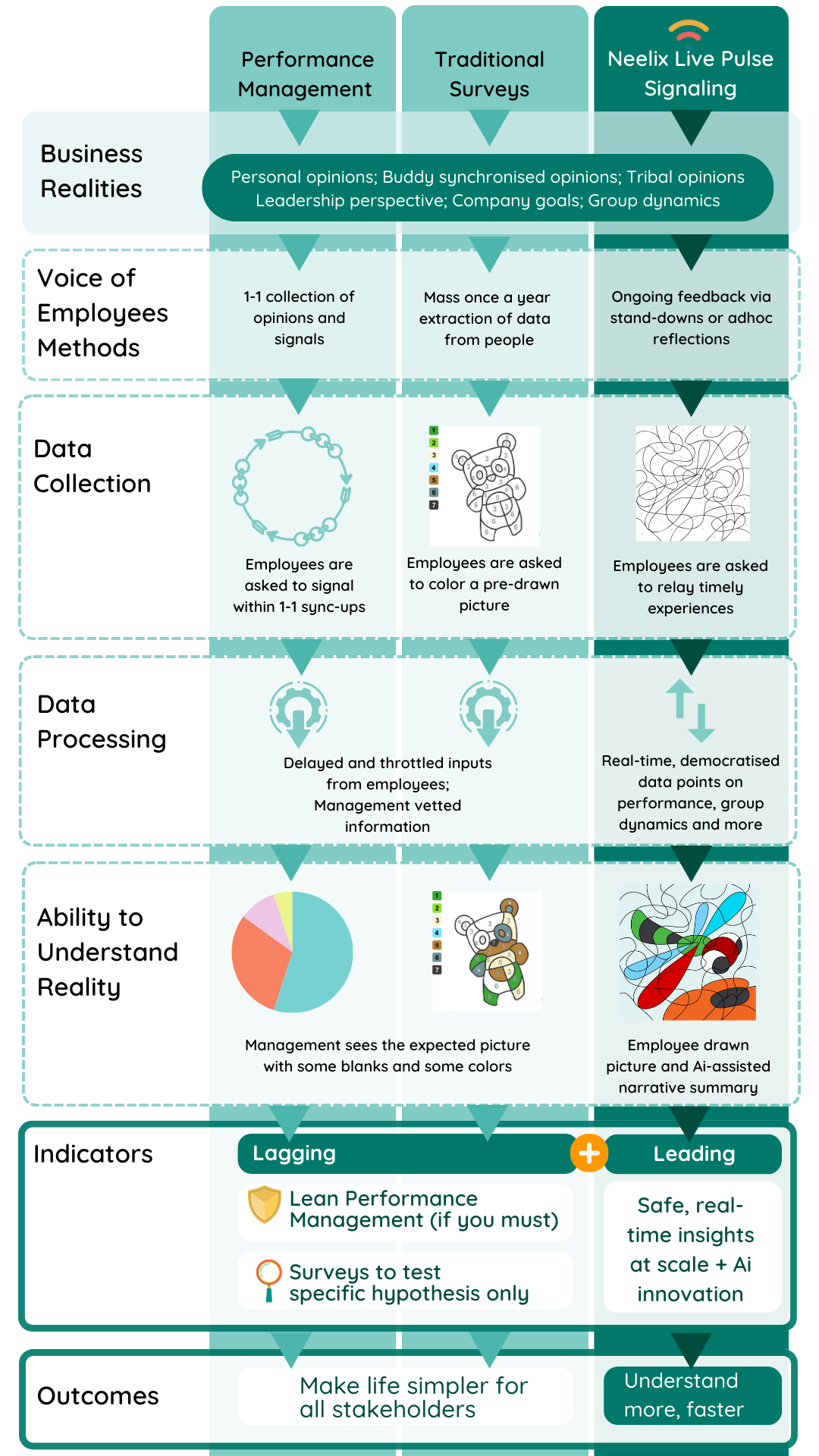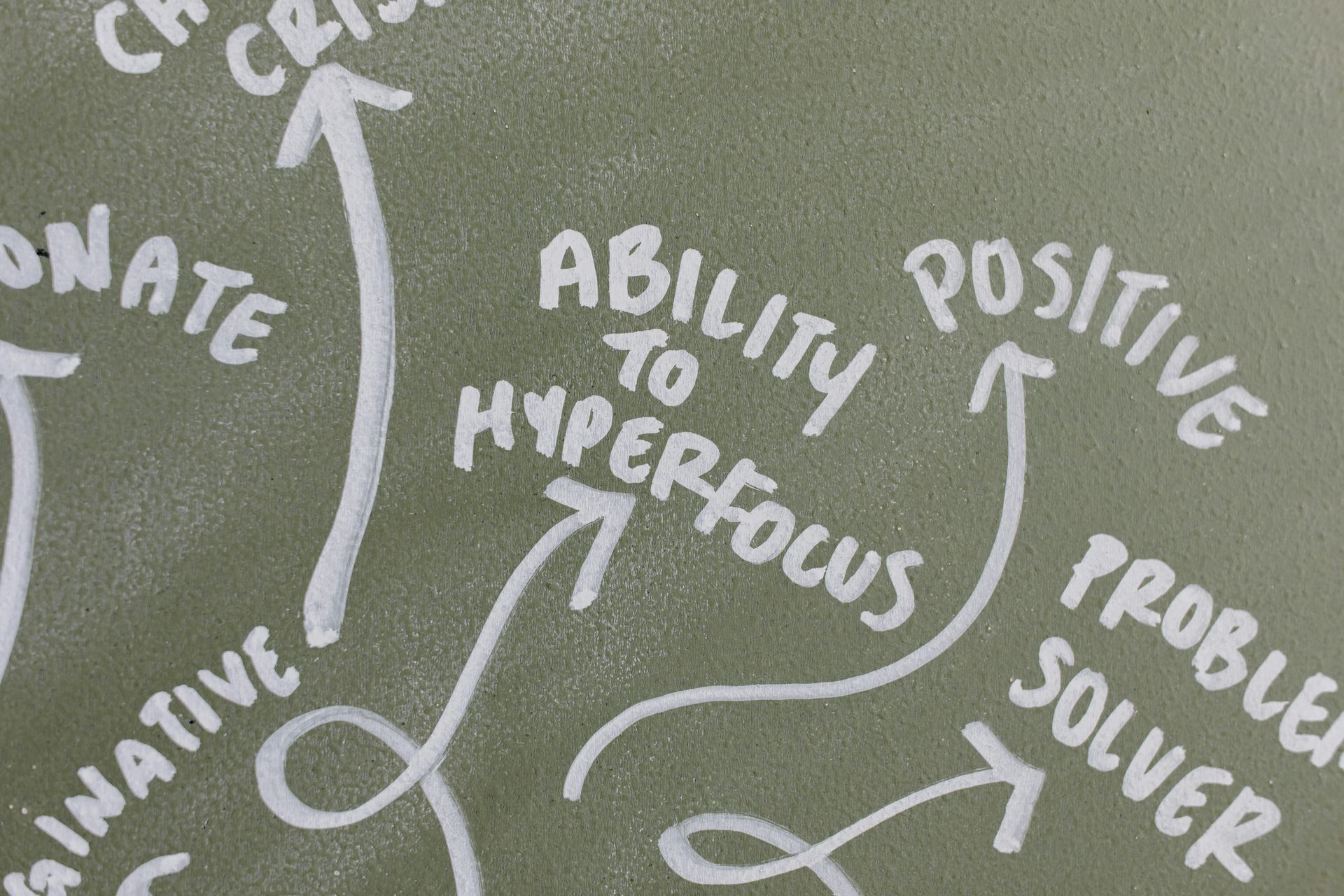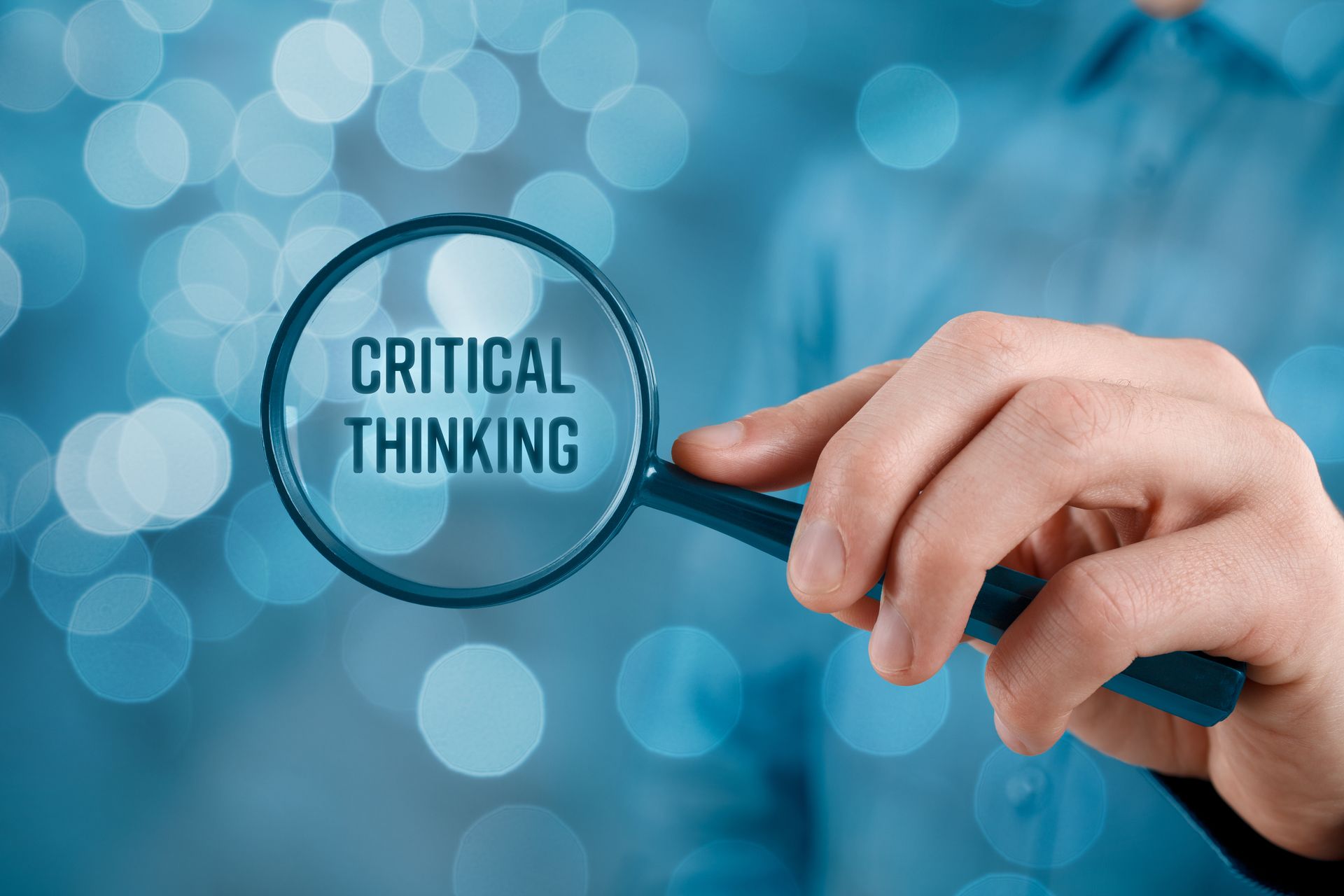How to Build Democratised Engagement Architecture for Workplace
Workplace engagement challenge
In the rapidly evolving world of work, Human Resources leaders are increasingly challenged with fostering an engaged workforce. The average statistics are daunting: 70% of employees are disengaged, 50% of employees have concerns with poor manager quality, there’s a 13% rise in mental health issues, and a significant portion of Gen Zs and millennials feel mentally distanced and cynical about their work. Amidst these challenges, HR leaders must craft a nuanced, balanced employee engagement architecture.
What executives are asking for is a robust efficiency management system that provides real-time, reliable data from all departments, enabling evidence-based decision-making to drive the business towards exceptional performance and sustainable growth.
This article explores how careful integration of operational performance management, traditional surveys, and modern feedback loops can transcend industry averages and create meaningful, long-lasting engagement.
Assumptions and Hypothesis
Two assumptions influence the debate:
- Traditional employee engagement surveys delivery very little value because they are lagging indicators by nature; The data is typically delivered to executive consideration with a 12+ months delay (e.g. a survey performance in September for "last years experiences" is delivered to decision makers with some additional lag)
- Traditional performance management does not really develop people, but for some it is a necessary process for compliance reasons
Hypothesis:
- Performance focused organizations need to a better engagement architecture which pivots from lagging to leading indicators, and the one that reduces the sense of chores / avoidable overheads
Trends
Trend 1 - Bloating of approaches and solutions
Given the recognition that employee engagement is directly linked to organizational performance, it became an important topic. Gallup research has been depicting little fundamental change in this area from year to year.
The key trend is that the approach to employee engagement is stagnating. This can be explained by few factors:
- Employee engagement became an imprecise term that conflates many aspects that are really different considerations. Orgsanizations have been spending resources on one-size-fits-all employee engagement metric that bundles satisfaction, employee retention, employee experience, or company culture.
- The surveys are often misinterpreted as positive results. For instance, surveys with 80% participation and 40% those who responded indicating some disagreement are often interpreted as good results because a discrete metric moved from 3.6% to 3.8%. Surveys became overanalytical, conflated and removed from how employees really feel. Goodhart's law demonstrates the danger of becoming over-focused on metrics and not the meaning.
- Response to surveys often demonstrates a lack of desire for actual change. Traditional managerial response to a lack of trust in the decision-making process is to explain more to staff the decisions made, even though staff know quite well why decisions are made, they simply do not trust how the consequences of the decisions will be handled.
HR software solution providers have been reacting to the trend of stagnation in ways that creates bloat:
- Performance management and HRIS providers are trying to develop some forms of additional signalling to capture employee thinking. These changes will provide little or even negative ROI - individual performance assurance systems are not suitable for inspecting group dynamics or for challenge the status quo, especially if there are issues within management.
- Survey solutions providers are trying to respond to industry experience that only 22% of companies get useful results from their surveys and to findings that up to 50% of survey respondents may provide dishonest answers. The response has been to double-down on tricks designed to prevent people from giving dishonest answers. The return on investment for such approaches will be low because they are not new and no revolutionary changes in the ability to understand employees have been achieved.
There is a trend for software providers advertising their products as boosting performance, belonging or company culture. The truth is, no employee engagement software can improve those - only real world outcomes and relationships can. More importantly, organizational efficiency and productivity are a function of an effective operating model, genuine leadership, and capabilities to continuously improve.
Trend 2 - Emerging clarity
In the last decade, it became fashionable to try and affect employee engagement via varying forms of appeasement and support because they target an employee as the subject.
However, it is becoming widely recognised that the root cause of challenges to employee buy-in are senior leadership and what happens in the middle management. Research confirms that 70% of a team’s engagement is directly tied to their manager (Gallup). At the same time, 72% (leaders) report that they often feel used up at the end of the day, an increase from 60% in 2020 (Global Leadership Forecast 2023, DDI).
There is a form of crisis in leadership, managerial capabilities, management support and mentoring of modern techniques. There are multiple perspectives associated with the stresses observed within managerial ranks. The solution resides deep within adult dialogue between leadership and employees, and not within the over analytical metrics.
No matter how highly a leader values her /his abilities, one can only see the tip of the iceberg.The term “the iceberg of ignorance” (1989, Sidney Yoshida) calls out the fact that because an organisation’s senior leaders are a few steps removed from its day-to-day operations, they’re aware of just 4% of all their business’s problems.
Successful modern leaders buy into two notions:
- "The first principle is that you must not fool yourself and you are the easiest person to fool" - Richard Feynman
- “It ain’t what you don’t know that gets you into trouble. It’s what you know for sure that just ain’t so” - most frequently attributed to Mark Twain
If your organization is dealing with complexities and consistency challenges, the chances are high that these notions are not well represented within your leadership. Whilst it is possible to engage external consultants to instigate the change, this experience of externally induced change can be hit and miss. Similarly, the impact of internal change champions is likely to be capped or slowed down by existing politics.
Neither performance management signals, nor traditional surveys, nor enhanced management communications can offer a magic solution to the problem of discovering new avenues for efficiency. A simple reason for this is that "90% of good ideas don't come from the executive suite" - Handling Complexity with Professor Richard Jolly, London Business School.
All modern research and successful practice point to the proposition that organizational performance can only be achieved through psychological safety and
collective intelligence. The emerging trend is realisation that employee engagement architecture is missing the
Live Pulse model
as the facilitator and the data lake of collective intelligence.
Most organizations lose valuable data at the organizational level because their Agile efforts and the “voice of employees” efforts are not systematised. This is why building high efficiency and collective intelligence is challenging for firms that double-down on traditional approaches.
How to design a modern employee engagement architecture
Modern employee engagement architecture is directed by three principles:
- A set of highly lean, efficient and fit-for-purpose processes
- A setup that prioritises real-world adult dialogue, but also captures contextual and measurable data points necessary for reflective thinking, alignment and quick decision-making
- A system through which employees and leaders maintain a healthy mutual accountability
Most organizations have pockets of good leadership and high performance teams. How does one translate and propagate that practice across the organization for the sake of collective higher performance and efficiency?
Experienced leaders know that there are multiple perspectives to any challenge. The parable of the blind men and an elephant illustrates the fact it is possible to have measurable experience that results in wrong advice when considered tribally.
Each of traditional employee engagement methods is akin to a blind wiseman trying to understand the elephant:
- Performance management process easily identifies underperforming employees, but cannot expose additional information locked behind line managers who are average (not necessarily bad) leaders
- Traditional surveys can identify some proportions of the “animal” in the room, but cannot empower the quiet majority to call out if the elephant is actually a three headed dragon from their perspective
- Leadership communications and managerial pulse checks on how employees feel can identify some specific sore points, but often backfire through less than systemic actions, unintended reinforcement of tribal perspectives and even status quo politics
The journey towards a wise collective intelligence is predicated on the ability to reimage the architecture of employee engagement in your organisation.
Recommended architecture - separation of concerns:
#1: Operational checkpoints
- Optimise existing performance management (if you must have one) in a way that reduces overheads on everyone - avoid re-introducing 360 degree reviews or additional data capture into this process
- Stop investing into generic surveys, and use surveys only for testing specific hypothesis
#2: Dialogue rails
- Replace generic surveys with the Live Pulse model and redirect investment into coaching employees and leaders on building collective collective intelligence
The key benefit of this architecture is that you can discover reliable understanding about what needs changing to achieve high performance within 3 to 6 months of switching away generic surveys - contact us for a demo and free consultation.
Other Benefits of this architecture:
- Does not increase total costs because you simply switch effort from administering surveys to coaching safe and joint reality inspection via the Live Pulse model
- Make everyone’s lives simpler and roles more strategic - less administrative work for middle management, HR and change champions as focus shifts from gathering and dissection of analytics to appreciation of narrative and discovery through dialogue
- Engages Ai assistant capabilities in a safe and impactful way because Live Pulse model provides and highly authentic and psychologically safe data lake
- Delivers fast and sustainable impact on the ability to appreciate multiple perspectives
- Enables faster and evidence-based decision making
- Guaranteed outcome of employees feeling that they were heard
- If external assistance were still needed, then given the inherent capacity for change, bringing in change consultants might produce much better results
Figure: Modern Employee Engagement Architecture -
Live Pulse model as the critical leading indicator

* Read more on detailed comparison of tools and solutions
Where to begin
Re-architecting employee engagement is easy:
- Take feedback from managers and employees on how performance management can be re-imagined with focus on operational concerns (everyone knows what they are)
- Introducing the Live Pulse model and establishing a collective intelligence data lake is achievable within very few minutes: (a) create a space on Neelix Platform, (b) add integrations from the marketplaces of Microsoft Teams or Slack - learn more and contact us for a demo.
Modern employee engagement architecture provides a better balance between operational and People & Culture needs. The Live Pulse model empowered development of programs that uplift managerial capabilities, re-energise employees and create the conditions for a more sustainable and engaged workforce.



